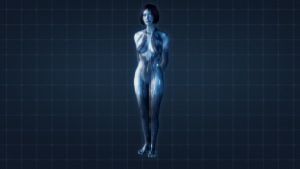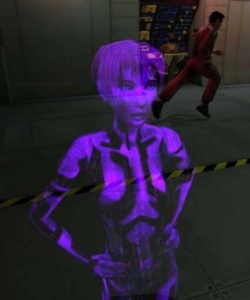
Cortana: Gender Devolved
For many, the summer’s release of Windows 10 marked a return to form for the venerable series of PC operating systems. It minimized the presence of the much reviled “Metro” styling, restored the Start menu to its former prominence, and made the OS free to anyone who already had either Windows 7 or 8 installed. One software feature, however, cited a return of another kind – Cortana, previously the sarcastic AI companion to the Master Chief in the Halo series of video games, arrived to Windows 10 as its “virtual assistant.” Cortana, like its voice-activated counterpart over at Apple, Siri, is essentially a glorified search engine crossed with a task manager that was then given a computerized (and feminized) voice. In Windows 10 you can just as easily use your search bar to find a file as to find out what kind of music Cortana likes. Which, if you’re wondering, is apparently “emo-hard-core-diva-dubstep.”
While Cortana was making her way back onto screens and into the speakers of Windows 10 early adopters, I was making my own return to the game in which she first made her appearance, Halo: Combat Evolved. I could go on for pages and pages about how much that game meant to me as a 14-year-old kid with his first video game console. Some of my most treasured video game memories come from my original playthroughs of Halo: CE. Often cited as the definitive proof that first person shooters could survive on the console instead of primarily being a PC phenomenon, Halo excelled at creating thrilling set pieces within a rich universe that alternated from beautiful to terrifying to hilarious. These moments, upon my nostalgic return to the game, were as vibrant and dynamic as I remembered them. What I did not account for, however, was the steadying presence that the mostly body-less Cortana provided amidst the bright colors and chaos.
Cortana keeps you oriented in an alien world
As I re-played Halo: CE, it struck me as simultaneously bizarre and fitting that Cortana should re-surface not as a character but as a software feature in the Windows ecosystem. My freshest memories of Cortana were from the latter Halo games, games where the AI character had begun to resemble more conventional narrative tropes of damsels in distress. Correspondingly, those more recent games – Halo 4 in particular – feature a version of Cortana whose holographic body appeared more solid, more curvy, and more physically present than previous iterations.
Cortana’s body in Halo: CE and Halo 4
Contrast this to Cortana of Halo: CE, who for the vast majority of the game lives in the circuits of Master Chief’s cybernetic armor. Cortana makes her presence known primarily as a voice, speaking directly to Master Chief (and players) by way of their cybernetic link, only taking on a holographic form of her own when she needs to be plugged into a computer terminal of some kind. In many ways, Cortana feels unique among women characters in video games precisely because of her shifting embodiment. She is an AI, of course, but compared to the stolid, green armored figure of Master Chief, her running commentary on players’ adventures feels incredibly human. When she does appear in holographic form, Cortana’s visual design seems only to remind players of her un-corporeality: she is translucent at best, streams of data move up and down her “skin,” and often she is miniature. Her mode of embodiment for the majority of the game is to literally share the skin of Master Chief, and when she takes on other forms it is in ways that visually mark her as unavailable to the most common vectors for the male gaze. In other words, Cortana is a character whose primary mode of relation to players is via conversation, not as a sidekick, a woman to be rescued, or an object of desire, but as a military asset, equal in value to the player-controlled Master Chief and perhaps even exceeding in many ways his own humanity. Master Chief and Cortana then are two cyborgs, paired on behalf of humankind to stand against the alien threat.
It’s this feeling of human relationship and partnership in a shared task that I think made Cortana so endearing to me when I first played Halo: CE and when I picked it up again almost 15 years later. It’s also why later iterations of Cortana as a sort of sexy cyborg who, due to the nature of her AI mind, is deteriorating rapidly and dangerously into madness, never connected with me.
Don’t make a girl a promise you can’t keep.
Some called the newer versions of Cortana more “humanizing,” I can see why they might feel that way. Her newer forms do have a heavier sense of corporeality and the introduction of a kind of AI mental illness and mortality certainly give Cortana some challenges to face that feel very human in nature. However, as Cortana’s mode of embodiment became more solid it also became more chained to regressive modes of visual representation that require women to be sexually desirable to the male eye. It seems hardly accidental to me that these changes in visual design accompany a narrative drift away from pairing Master Chief and Cortana as co-warriors in the fight against the Covenant and toward a rather hetero-erotic repetition of male rescue narratives and female hysteria. As you might expect with these developments, by the end of Halo 4, Cortana’s self-sacrifice for Master Chief is the only path to narrative resolution.
Master Chief’s sad face as Cortana sacrifices herself.
This is why it was so pleasantly surprising to find Cortana once again greeting me as an unseen voice from a screen via Windows 10. Perhaps inadvertently, Microsoft had found a way to restore a more human and companionable iteration of the character that broke off the slide she had experienced in the games toward token eye candy. What I found instead was nothing more than the bare skeleton of the character I once loved spending time with, a disembodied voice whose wit and snark had disappeared into haze of sycophantic supplication. The Cortana of Windows 10 is no AI. Much like Cortana’s favorite music, the humanity to be found here is just a mish mash of focus tested jokes and aphorisms.
On the one hand, my disappointment here is probably a little silly. Of course the Cortana of Windows 10 was always going to be a shallow competitor to Siri, not a return to form of one of my favorite video game characters. Instead of restoring the character to a position of equality, the Windows 10 iteration removes her humanity entirely, forcing her to occupy a position of absolute servitude. On the other hand, in Windows 10 and Halo 4 we have the exemplary poles of possibility for female representation in video games. She must either be the subservient, disembodied afterthought or the erotic, fully female and fully psychotic damsel in distress. To think on the strange, iterative life of Cortana across platforms and narratives is to encounter the narrow silos into which women are often shuffled according to patriarchal modes of appropriate embodiment.
Curiously, the Windows 10 Cortana has not yet made it to the Xbox One platform, though I’m sure eventually it will. I wonder what the Halo: CE Cortana will think of her arrival.
Jordan Wood is a Ph.D student in the Syracuse University English department where he studies games, sexuality, and queer theory. He lives with two cats and is terrible at side scrolling games. Go Bills.
You may also like
Related
No comments
Archives
- April 2025
- March 2025
- February 2025
- September 2024
- February 2024
- January 2024
- October 2023
- May 2023
- March 2023
- February 2023
- December 2022
- November 2022
- October 2022
- May 2022
- April 2022
- March 2022
- February 2022
- December 2021
- November 2021
- October 2021
- June 2021
- May 2021
- April 2021
- March 2021
- March 2020
- February 2020
- December 2019
- November 2019
- October 2019
- September 2019
- August 2019
- April 2019
- March 2019
- February 2019
- January 2019
- December 2018
- November 2018
- October 2018
- September 2018
- April 2018
- March 2018
- February 2018
- January 2018
- December 2017
- November 2017
- October 2017
- September 2017
- May 2017
- April 2017
- March 2017
- February 2017
- January 2017
- December 2016
- November 2016
- October 2016
- September 2016
- April 2016
- March 2016
- February 2016
- January 2016
- December 2015
- November 2015
- October 2015
- September 2015
- May 2015
- April 2015
- March 2015
- February 2015
- January 2015
- December 2014
- November 2014
- October 2014
- September 2014
- August 2014



Reblogged this on Queerly Different.